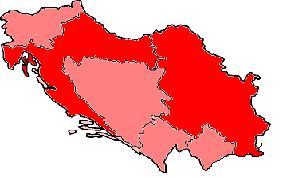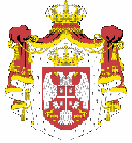Democratic Republic of Croato-Serbia
| |||||
| State Motto:Victoria Concordia Crescit | |||||
| Anthem: Hej Slaveni! | |||||

| |||||
| Official Language(s): | Serbian, Croatian, Serbo-Croatian, Croato-Serbian | ||||
| Capital: | Zagrad | ||||
| President: | Vladimir Broz | ||||
| Prime Minister: | Slobodan Tuđman | ||||
| Area: - total: - % water: |
144.903 km² 0,26% | ||||
| Population: - total (2006.): - Density: |
14,329,991 187,36/km² | ||||
| Establishment: | September 3rd 1945. | ||||
| Currency: | duna (dipa) | ||||
| Time Zone: | UTC +1 | ||||
| Internet TLD: | .c-s | ||||
| Calling Code: | +911 | ||||
The Democratic Republic of Croato-Serbia is a country in the south-east Europe. It is large as half of the former SFRY. It was establiched on the 3rd September 1945. It is a new state that bloomed in 1976. It excahenged 23 flags since her establichment (which you can see here. The currency (duna & dipa) is the combination of the former Serbian dinar, and the Croatian kuna.
Contents
History
After the fall of the SFRY in 1945, after the terrible Internal war, 6 countries gained independence. Croatia, Serbia, Slovenia, Bosnia i Herzegovina, Macedonia & Montenegro gained independence. Six countries that were undeveloped were destined to form an alliance, so the representatives of the 6 countries, Janez Vraz (Slovenia), Mihailo Drašković (Serbia), Marko Radić-Trumbić (Croatia), Memsud Bešlagić (BiH), Aco Stasov (Macedonia) i Vuk Njegoš (Montenegro) signed the PSFRY pact in which they formed an union (alliance) of all post-SFRY states. The south-eastern countries (BiH, Macedonia, Montenegro) formed a country known as the State MBM, and Croatia and Serbia formed the Democratic Republic of Croato-Serbia, and Sloveina is the only state that kept its independence.
The DR Croato-Serbia was not a powerful country, an it had many internal revolutions and cuops that tried to establish SFRY again. The only succesful attemp of the revolutionaries was the assasination of the 1st president - Pavle Maček on September 5, 1954. The assasin was cought, and the 2nd president and former minister of the exterior Pavle Radić-Trumbić made a law that made all revolutionaries and former SFRY parties illegal.
The country reached is bloom in 1976, durning the republican rule of Franko Basariček. He increased economic, financial and agricultural incomings in the state. This period from 1976 to 1980 is know as the Basariček reformation or the bloom of Croato-Serbia.
Afteer Basariček, the bloom stopped a little, but the political rising of Croato-Serbia started. They made many political bonds with many coutries all over the world. Croato-Serbia is now a mighty country in their region, and a good one in the world.
Geography
Croato-Serbia has a variety of geographical areas. From beaches and the sea in the south, the mountains and snow in the east, corn fields in the west and mighty rivers in the north. So the government divided these four sides into regions. The regions are:
- Mletachia - capital Dandoloville
- Historium - capital Arenitas
- Gromadas - capital Radinovo
- Slavenica - capital Mursa City
- Chirilicia - capital Gramargrad
Politics
Economy
Ethnology
Languages
Religion
Croati-Serbia hasn't many religions. Trough history only islam and christiany have come in this country. The islam has faded much, but christiany stayed. This is a list of religions in Croato-Serbia:
- Christiany: 75%
- Catholicism: 45%
- Orthodox: 30%
- Islam: 25%
The islam that was here came trough the influence of the Ottoman Empire.
Culture
Music
Art
The art of Croato-Serbia is one of the most best in the world. It has spreaded on all the branches.
Visual arts
Painting and sculpturing is very advanced in Croato-Serbia. The painter are painiting mostly in the romantic influence, altoiught there are modern, suurealist, expressionist, and other branches. The most famous Croato-Serbian painters are: Eugen Delakroat, Henri Matis, August Reno, Albert Duhrer, Leonardo Santi, Vladko Kandinski and others.
Sculpturing is mostly on the reinessance influence, and in the antic influence. The most famous sculptors are: Mihal Bunaroto, Filip Dija, August Cesarec.
Movies
Croato-Serbian movie industrie has many famous films and directrs. It is in the influence of the UK movie distribution. The famous directors are: Alfred Hitchok, Bruno Ganc, Ivan Kleese, Daniel Kroft and others.
Not many actors are good in Croato-Serbia beacuse they all went outside to get better jobs. The most famous actors are: Leona Serbedzija, Anita Buren, Filipa Navojec, Rene Filipović, Roko Prč and Bata Cvetković.
Movies from Croato-Serbia are very good and complex. The thriller, horror and crime genres are the most famous, but there are some good comedies, drama's and other movies.
Literature
Literature in Croato-Serbia is one of the most appriceated and advanced in the whole world. It missed many periods in old art, but it is in the influence of modernism. It has novelists, dramatists and poets. The first know work that was publiched is The Case of the "Black Horse" by Artur Poe. It was published Septrmber 4th 1945 and it is a crime novel. Later there developed horror and thiller novels, and from that was born fiction and science-fiction. The representatiuves of the horror genre are Leonora Nikolina Tomić, Jovana Lelović and Marija Kozarac, of the thriller genre are Lukas Papačić and Anton Čehov. From the fiction genres they developed their fairy tales to a very high level, by authos like Andrej Jozić.
The Drama and the Comedy in Croato-Serbia is almost as foums as Shakespeare's. Maybe beacuse Shakespeares great-great-great-great-great-great-great grandson was born in Gramargrad in 1921. Tomislav Shakespeare began writing dramas like Hamlet II: The Truth and On New Years Eve or How I Got My Name that are now famous and world wide read. The best comedy writer is Enriko Torpolli, a Mletachian writer that is famous for the comedy The Tragic Comedy of Fellipe Torpolli.


